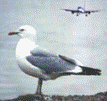Bird Strike Committee Proceedings
Date of this Version
August 2006
Abstract
The paper reports on lessons learnt from an avian radar trial conducted at Toronto Pearson International Airport in November 2005. Toronto Pearson International Airport is Canada's largest airport and has unique requirements due to its proximity to metropolitan Toronto, a major urban center. The paper begins with an assessment of desirable application requirements that take into account current wildlife management practices. Application requirements include early warning of birds approaching the airfield; real-time tracking of birds and aircraft, rapid review of overnight bird movements to identify bird stopovers, and integration into wildlife management operations. Next, the paper examines special radar design requirements at large airports like Toronto Pearson International. The presence of multiple runways and the large airfield lead to a requirement for multiple radars. This in turn leads to a radar system solution that includes multi-sensor fusion which places significant demands on real-time tracking and target data distribution. Restrictions on the sighting and operation of radars lead to radar engineering trade-offs. These include trading off the best location and height for the antennas used and their types to minimize blockage, maximize coverage, minimize interference and control clutter. Finally, the proximity of dense urban vehicular traffic in vicinity of airport leads to specialized processing requirements to manage vehicular clutter while not compromising bird tracking performance. The paper includes photographs and real radar data to convey the issues and the lessons learnt.

